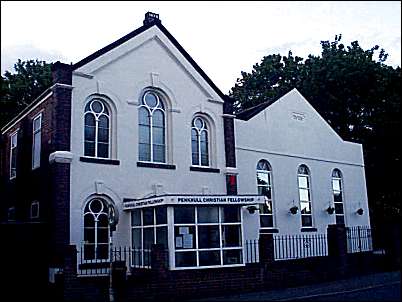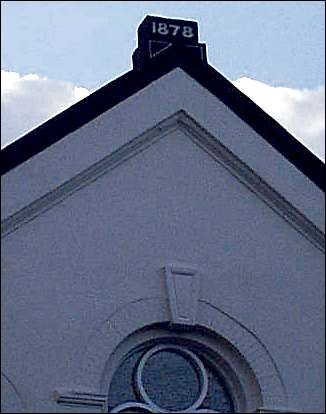Josiah Spode II (1754-1827) and The Mount Estate (Penkhull)
The Primitive Methodist chapel in Penkhull Square
Location 12 on
the index map

The chapel in 2000, the right hand building - the original 1836 chapel and the left hand is the 1878 extension.

The 1836 date-stone, Hugh Bourne was a trustee of the original chapel.

The 1878 date-stone on the extension
Bourne, Clowes and "Mow Cop"
Around the same time as the rise of the Methodist New Connexion, another wave of revival swept into the new towns. Its leading figures were Hugh Bourne and William Clowes. Hugh Bourne, was born at Ford Hayes Farm, Bucknall, on April 3, 1772. He was a shy man who, until his conversion in 1799, lived with an intense fear of falling into hell. By the year 1800, he had moved to live in Harriseahead, a village to the north of the present city. Towering above Bourne's new home was Mow Cop, a "bald hill" rising to 1,091 feet above sea level, with commanding views over the Cheshire plain.
Bourne was shocked at the moral state of his new neighbourhood, saying, "There was not in England a neighbourhood that was more ungodly and profane. A stranger could hardly go over Harriseahead without insult and sometimes not without injury." Against this background, Bourne met for prayer and Bible study with other Methodists, and flames of revival broke out in 1801, spreading quickly through the northern towns of the Potteries and beyond.
William Clowes was born in Burslem on March 12, 1780, a relative of Josiah Wedgwood on his mother's side. William became a highly skilful master potter, as well as a notorious drinker, gambler, womaniser and fighter, but was remarkably converted at an evangelistic meeting in Congleton in 1804, following what Hugh Bourne described as yet another "extraordinary outpouring of the Spirit." Clowes was to become a powerful evangelist and a leader in the revival.The Primitive Methodists
One of the main features of this new move of God was the "Camp-meeting," an all-day, open-air prayer and preaching meeting. The first one was held at Norton in 1807; thereafter they moved to Mow Cop, replete with its mock castle ruins, a folly built by Squire Randle Wilbraham of Rode Hall in 1754, just over fifty years prior to these events. Many were the sinners converted and miracles accomplished on these glorious occasions.
Unfortunately, these American-style meetings were viewed with great suspicion by the Methodist authorities and a ban on holding such gatherings was imposed. Having ignored this ruling, both Bourne and Clowes were eventually expelled from the Methodist Church (in 1808 and 1810 respectively). Despite this set-back, the new movement continued to grow, spreading throughout the Midlands and the North of England, following the line of the River Trent to Hull, where Clowes died and is buried.
next: is
St. Thomas's - the Church of England church.
previous: was Beech Grove
questions/comments/contributions? email: Steve Birks